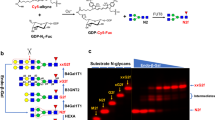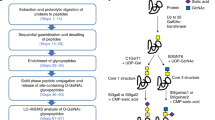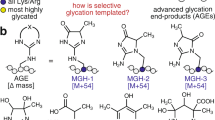Abstract
Advanced glycation end products (AGEs) contribute to changes in protein conformation, loss of function, and irreversible crosslinking. Using a library of dipeptides on cellulose membranes (SPOT library), we have developed an approach to systematically assay the relative reactivities of amino acid side chains and the N-terminal amino group to sugars and protein–AGEs. The sugars react preferentially with cysteine or tryptophan when both the α-amino group and the side chains are free. In peptides with blocked N-terminus and free side chains, cysteine, lysine, and histidine were preferred. Crosslinking of protein–AGEs to dipeptides with free side chains and blocked N termini occurred preferentially to arginine and tryptophan. Dipeptide SPOT libraries are excellent tools for comparing individual reactivities of amino acids for nonenzymatic modifications, and could be extended to other chemically reactive molecules.
This is a preview of subscription content, access via your institution
Access options
Subscribe to this journal
Receive 12 print issues and online access
$209.00 per year
only $17.42 per issue
Buy this article
- Purchase on Springer Link
- Instant access to full article PDF
Prices may be subject to local taxes which are calculated during checkout






Similar content being viewed by others
References
Miyata, T. et al. Glycation of human β2-microglobulin in patients with hemodialysis-associated amyloidosis—identification of the glycated sites. Biochemistry 33, 12215–12221 (1994).
Miyazaki, S. et al. Advanced glycation end products are associated with beta(2)-microglobulin amyloidosis. Am. J. Nephrol. 15, 535–536 (1995).
Smith, M.A. et al. Advanced Maillard reaction end products are associated with Alzheimer disease pathology. Proc. Natl. Acad. Sci. USA 91, 5710–5714 (1994).
Vlassara, H. Advanced glycation end-products and atherosclerosis. Ann. Med. 28, 419–426 (1996).
Friedman, E.A., Distant, D.A., Fleishhacker, J.F., Boyd, T.A. & Cartwright, K. Aminoguanidine prolongs survival in azotemic-induced diabetic rats. Am. J. Kidney Dis. 30, 253–259 (1997).
Vlassara, H. et al. Advanced glycation end products induce glomerular sclerosis and albuminuria in normal rats. Proc. Natl. Acad. Sci. USA 91, 11704–11708 (1994).
Horie, K. et al. Immunohistochemical localization of advanced glycation end products, pentosidine, and carboxymethyllysine in lipofuscin pigments of Alzheimer's disease and aged neurons. Biochem. Biophys. Res. Commun. 236, 327–332 (1997).
Miyata, T. et al. Increased pentosidine, an advanced glycation end product, in plasma and synovial fluid from patients with rheumatoid arthritis and its relation with inflammatory markers. Biochem. Biophys. Res. Commun. 244, 45–49 (1998).
Nakamura, K., Nakazawa, Y. & Ienaga, K. Acid-stable fluorescent advanced glycation end products—vesperlysines a, b, and c are formed as crosslinked products in the Maillard reaction between lysine or proteins with glucose. Biochem. Biophys. Res. Commun. 232, 227–230 (1997).
Wells-Knecht, K.J. et al. New biomarkers of Maillard reaction damage to proteins. Nephrology, Dialysis, Transplantation 11, 41–47 (1996).
Frank, R. Simultaneous and combinatorial chemical synthesis techniques for the generation and screening of molecular diversity. J. Biotechnol. 41, 259–272 (1995).
Reineke, U., Sabat, R., Volk, H.D. & Schneider-Mergener, J. Mapping of the interleukin-10/interleukin-10 receptor combining site. Protein Sci. 7, 951–960 (1998).
Rüdiger, S., Germeroth, L., Schneider-Mergener, J. & Bukau, B. Substrate specificity of the DNAk chaperone determined by screening cellulose-bound peptide libraries. EMBO J. 16, 1501–1507 (1997).
Frank, R. & Overwin, H. SPOT synthesis. Epitope analysis with arrays of synthetic peptides prepared on cellulose membranes. Methods Mol. Biol. 66, 149–169 (1996).
Molina, F., Laune, D., Gougat, C., Pau, B. & Granier, C. Improved performances of spot multiple peptide synthesis. Peptide Res. 9, 151–155 (1996).
Mayer, J.P. et al. Application of the Pictet-Spengler reaction in combinatorial chemistry. Tetrahedron Lett. 37, 5633–5636 (1996).
Wang, M.F., Jin, Y., Li, J.G. & Ho, C.T. Two novel beta-carboline compounds from the Maillard reaction between xylose and tryptophan. J. Agric. Food Chem. 47, 48–50 (1999).
Hipkiss, A.R., Michaelis, J. & Syrris, P. Non-enzymatic glycosylation of the dipeptide l-carnosine, a potential anti-protein-cross-linking agent. FEBS Lett. 371, 81–85 (1995).
Derosa, M.C. et al. Glycated human hemoglobin (HbA(1c))-functional characteristics and molecular modeling studies. Biophys. Chem. 72, 323–335 (1998).
Hilmes, C. & Fischer, A. Inhibitory effect of sulfur-containing amino acids on burnt off-flavours in canned liver sausages. Meat Sci. 46, 199–210 (1997).
Lo, T.W.C., Westwood, M.E., McLellan, A.C., Selwood, T. & Thornalley, P.J. Binding and modification of proteins by methylglyoxal under physiological conditions—a kinetic and mechanistic study with N-alpha-acetylarginine, N-alpha-acetylcysteine, and N-alpha-acetyllysine, and bovine serum albumin. J. Biol. Chem. 269, 32299–32305 (1994).
Mohan, R., Chou, Y.L. & Morrissey, M.M. Pictet-Spengler reaction on solid support —synthesis of 1,2,3,4-tetrahydro—-carboline libraries. Tetrahedron Lett. 37, 3963–3966 (1996).
Alabed, Y., Ulrich, P., Kapurniotu, A., Lolis, E. & Bucala, R. Model studies of the Maillard reaction of Arg-Lys with D-ribose. Bioorg. Med. Chem. 5, 2929–2930 (1995).
Odani, H. et al. Imidazolium crosslinks derived from reaction of lysine with glyoxal and methylglyoxal are increased in serum proteins of uremic patients—evidence for increased oxidative stress in uremia. FEBS Lett. 427, 381–385 (1998).
Moreaux, V. & Birlouez-Aragon, I. Degradation of tryptophan in heated beta-lactoglobulin-lactose mixtures is associated with intense Maillard reaction. J. Agric. Food Chem. 45, 1905–1910 (1997).
Obayashi, H. et al. Formation of crossline as a fluorescent advanced glycation end product in vitro and in vivo. Biochem. Biophys. Res. Commun. 226, 37–41 (1996).
Frank, R. SPOT synthesis: an easy technique for the positionally addressable, parallel chemical synthesis on a membrane support. Tetrahedron 48, 9217–9232 (1992).
Acknowledgements
We thank Rosemarie Kientsch-Engel, Helmut Lill, Alan Hipkiss, Jürgen Michaelis, Siegfried Hoyer, August Heidland, Geoff Grigg, Ronald Frank, Markus Herderich, Stefanie Diem, and Robin Holliday for inspiring discussions; Bernhard Spengler for performing the matrix-assisted laser desorption/ionization time-of-flight analysis of the spot peptides; and ASTA Medica for continuous moral support. The assistance of Amanda Wong in preparing the manuscript is also acknowledged. This work was supported by the Claussen-Stiftung and by the Alzheimer Forschung International (to G.M).
Author information
Authors and Affiliations
Corresponding author
Rights and permissions
About this article
Cite this article
Münch, G., Schicktanz, D., Behme, A. et al. Amino acid specificity of glycation and protein–AGE crosslinking reactivities determined with a dipeptide SPOT library. Nat Biotechnol 17, 1006–1010 (1999). https://doi.org/10.1038/13704
Received:
Accepted:
Issue Date:
DOI: https://doi.org/10.1038/13704
This article is cited by
-
Revisiting Methodologies for In Vitro Preparations of Advanced Glycation End Products
Applied Biochemistry and Biotechnology (2022)
-
Molecular characterization of sequence-driven peptide glycation
Scientific Reports (2021)
-
Insights into the Chemistry of Non-Enzymatic Browning Reactions in Different Ribose-Amino Acid Model Systems
Scientific Reports (2018)
-
Investigation Into the Effects of Tenilsetam on Markers of Neuroinflammation in GFAP-IL6 Mice
Pharmaceutical Research (2018)
-
Inhibitors of advanced glycation end products from coffee bean roasting by-product
European Food Research and Technology (2018)



